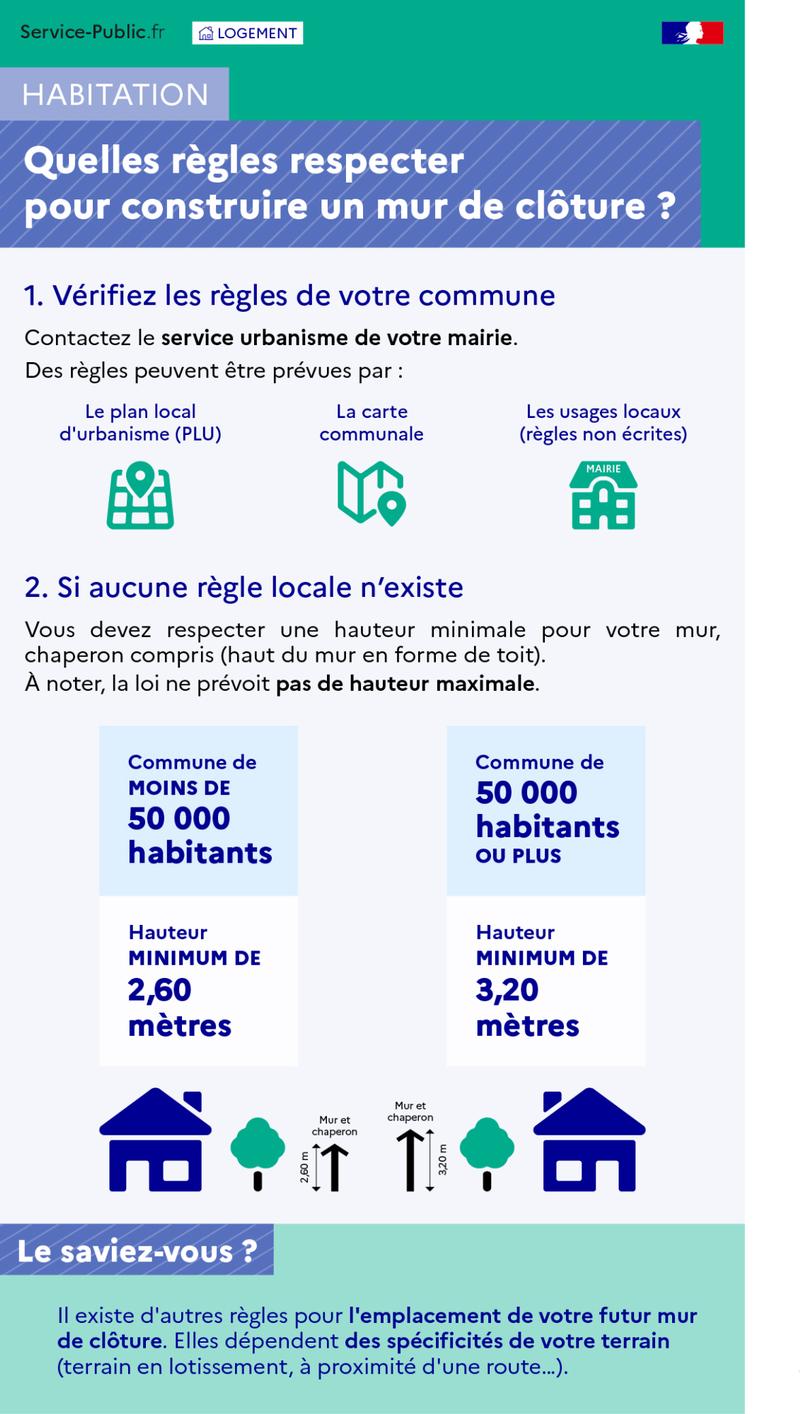What are the height and distance rules for a fence wall? - Wall
Verified 11 mai 2023 - Directorate for Legal and Administrative Information (Prime Minister)

Ouvrir l’image dans une nouvelle fenêtre
What rules to follow to build a fence wall?
1. Check the rules of your municipality
Contact the city planning department of your city hall.
Rules may be laid down by:
- The local city planning plan (PLU)
- The communal map
- Local customs (unwritten rules)
2. If no local rules exist
You must respect a minimum height for your wall, including a chaperone (top of the roof-shaped wall).
Note: the law does not provide for a maximum height.
- Commune of less than 50,000 inhabitants: minimum height of 2.60 meters
- Municipality of 50,000 inhabitants or more: minimum height of 3.20 meters
Did you know that?
There are other rules for the location of your future fence wall. They depend on the specifics of your land (land in subdivision, close to a road...).
You have to imperative contact the city planning department of your city hall to find out if there are any local rules to respect in relation to the neighboring land.
These rules may be laid down by the local city planning plan (PLU) or by the municipal map or by local customs.
If there are no local rulesHowever, we must refer to the law which lays down minimum height rules. These rules depend on the situation of your land.
Répondez aux questions successives et les réponses s’afficheront automatiquement
Your land is located on a commune of less than 50,000 inhabitants
Your wall including the chaperone when it exists (top of the wall in the form of a roof) must respect a minimum height of 2,60 meters.
Warning
the act does not provide for a maximum height. However, your wall should not cause abnormal neighborhood disorder (for example, loss of sight or sunlight).
Before building the wall, it is recommended to talk to your neighbor. If he accepts, you can then build the wall on the boundary separating your 2 plots by sharing the costs by half (this will also avoid a loss of land). The wall will then be adjoining. If your neighbor refuses (for example, he or she does not want to contribute to the construction costs or see a wall on his or her land), you will need to build the wall only on your land. Otherwise, your neighbor may demand that the wall be demolished or moved.
Your land is located on a commune of at least 50,000 inhabitants
Your wall including the chaperone when it exists (top of the wall in the form of a roof) must respect a minimum height of 3,20 meters.
Warning
the act does not provide for a maximum height. However, your wall should not cause abnormal neighborhood disorder (for example, loss of sight or sunlight).
Before building the wall, it is recommended to talk to your neighbor. If he accepts, you can then build the wall on the boundary separating your 2 plots by sharing the costs by half (this also avoids a loss of land). The wall will then be adjoining. If your neighbor refuses (for example, he or she does not want to contribute to the construction costs or see a wall on his or her land), you will need to build the wall only on your land. Otherwise, your neighbor may demand that the wall be demolished or moved.
Before you build the wall, you'll have to make a preliminary declaration of works to the city hall if you are in one of the following cases:
- The local city planning plan (PLU) requires it
- The height of the wall to be built is greater than or equal to 2 meters
- Your land is located in an area where it is mandatory. It can be the vicinity of a remarkable heritage site classified or a historic monument, a registered site (classified or awaiting classification), an area delimited by the PLU, an area defined by the municipality or theEPCI: titleContent.
Who can help me?
Find who can answer your questions in your region
For information
Telephone administrative information - Allo Public Service
For more information on this topic, you can contact Allô Service Public.
Attention: the service does not have access to users' personal files and cannot therefore provide information on their status.
- Lundi : de 08h30 à 17h30
- Mardi : de 08h30 à 12h15
- Mercredi : de 08h30 à 12h15
- Jeudi : de 08h30 à 17h30
- Vendredi : de 13h00 à 16h15
- Service free
The informants who answer you belong to the ministry in charge of housing and city planning.
For advice
Architectural, city planning and Environmental Council (CAUE)
Freedom to close
In the absence of local rules
Fence and free movement of wild animals
Service-Public.fr
Directorate of Legal and Administrative Information (Dila) - Prime Minister

